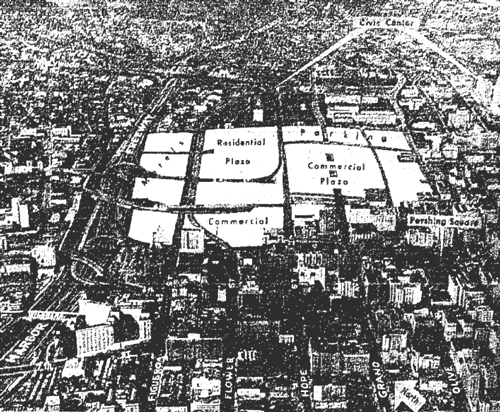 The history of Bunker Hill could not be written without mention of a man who stood up to face the foe. Who fought City Hall; who fought the law, and sure, the law won. But let‘s remember the man. Firebrand. Gadfly. Babcock.
The history of Bunker Hill could not be written without mention of a man who stood up to face the foe. Who fought City Hall; who fought the law, and sure, the law won. But let‘s remember the man. Firebrand. Gadfly. Babcock.
It‘s 1951, and we‘re faced with Proposition C, which sounded just swell: clear the city‘s slum areas and replace “ramshackle” tenements with modern apartments. The Times ran large pieces urging the voters to back C, citing a litany of political, business and union leaders supporting the measure (veterans‘ organizations termed the measure “a solution of a vital civic problem in the American way”).
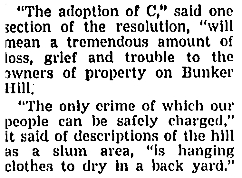 But one fellow didn‘t think the idea so all-American–owner of the Dome, president of the Bunker Hill Property Owners Association, Frank Babcock. The Association met before the election and passed a resolution announcing their opposition to Prop C (which would raze Bunker Hill, to be replaced by “12 blocks of new apartment houses”) whereby property owners would be forced to sell at condemnation prices; BHPOA also saw C as a scheme to take their property for the benefit of insurance corporations. Be that as it may, the voters decided Proposition C was the American Way (despite the Stalinist overtones of a government taking private property) and it passed. But you hadn‘t heard the last of Frank Babcock.
But one fellow didn‘t think the idea so all-American–owner of the Dome, president of the Bunker Hill Property Owners Association, Frank Babcock. The Association met before the election and passed a resolution announcing their opposition to Prop C (which would raze Bunker Hill, to be replaced by “12 blocks of new apartment houses”) whereby property owners would be forced to sell at condemnation prices; BHPOA also saw C as a scheme to take their property for the benefit of insurance corporations. Be that as it may, the voters decided Proposition C was the American Way (despite the Stalinist overtones of a government taking private property) and it passed. But you hadn‘t heard the last of Frank Babcock.
It’s important not to confuse our Frank Babcock with the anti-Babcock, or Babcock-Bizarro, if you will. Henry Babcock. Whether they‘re related we do not know, but it does tickle the imagination to think so. Why? Because Henry Babcock had been involved in the wholesale demolition of Bunker Hill since 1930. He arrived in Los Angeles from Chicago as one of William Babcock & Sons, real estate valuators and consultants, to study the feasibility of the “Bigelow Plan” (C. C. Bigelow‘s 1928 scheme for removing the Hill using hydraulic mining equipment) and how quickly a regraded Bunker Hill could be absorbed into downtown. Henry Babcock in-a-nutshell:
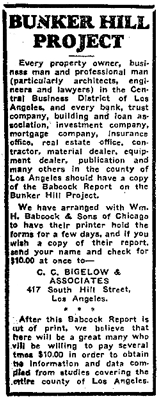
“There is no community, it is found, that is entirely free from spots or sections that by reason of antiquated structures, topographical conditions or congestion have depreciated in value and also are having an adverse effect on adjacent areas. This is on the principle of the spoiled apple in the barrel. In fact, directly or indirectly, these depreciated areas threaten a bad effect on entire municipalities.
“They cannot by fenced off and left to their fate. They cannot be segregated to work out their own salvation regardless of the rest of the community. Consequently they present a problem of concern to the entire city in which they are situated. Naturally, the rehabilitation of blighted areas is governed entirely by the conditions involved.
“In the instance of Bunker Hill the matter of topography enters largely into consideration. Admittedly it is a traffic barrier not only for itself but for extensive and growing sections at every side of it. Architecturally it has not kept pace with the modernly growing parts of the city. It apparently presents a striking need for rehabilitation if it is to share in the indicated improvement in realty values. Modern engineering methods lend themselves expeditiously to the razing of this are or any part of it and without undue interference with a natural volume of traffic with the work is under way.”
Babcock, after presenting a ninety-six page report about razing and regrading Bunker Hill to the City Council, decided to stay in Los Angeles as a vice-president of the Mitchel-Brown & Co. Spring-Street investment house.
Then, there was to be a Babcockfight. Henry Babcock shows up again in 1951 as a consulting engineer for Proposition C. He outdoes the CRA by drawing up plans for thirty-seven thirteen-story apartment complexes on 73 acres, four 600-car parking garages, and open paved lots for 2560 autos. Parking and retail buildings were to be located in the center of Bunker Hill.
In February of 1955 Frank Babcock strolled down from his Dome to Superior Court and slapped the Community Redevelopment Agency with an injunction to block the development (the City, and all the members of the City Council [with the exception of Edward R. Roybal, who‘d voted against BH redevelopment] were also named as defendants).
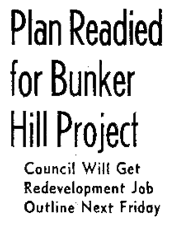
Babcock asserted that the law was clear: the CRA could only demolish blighted areas. The structures and set-up of Bunker Hill, Babcock argued, met City ordinances‘ standards and filled the economic needs of the community, and further contended that (despite common belief and literary assertions to the contrary) Bunker Hill‘s buildings were safe for occupancy, not conducive to ill health, transmission of disease, juvenile delinquency, infant mortality or crime. And, owner of the Dome that he was, was proud to say that landowners on the Hill were planning development of their own properties and had no need for the “aid” of 40million+ condemnation dollars in taxpayer funds.
By June of 1956, William T. Sesnon, armed with Henry Babcock‘s financial, economic and architectural surveys, presented final plans to the City Council. As required by law, there was a public hearing; Frank Babcock presented his alternate proposals–lost to time, now. It would seem there was nothing Frank Babcock could do to stem the tide that would wash away Bunker Hill and his beloved Dome. Until he realized that tide was suffused with brea.
 Oil, that is. William T. Sesnon Jr., chairman of the Community Redevelopment Agency, is an oil magnate, after all. (‘Twas he who proposed the plan to finance homes for those elderly residents who had to be relocated from Bunker Hill: the City would drill on property bounded by Temple, Beverly, Union and Edgeware–one of LA‘s oldest oilfields–and the senior-citizen property owners would receive a one-sixth royalty interest with which they could pay their new rents.) And Sesnon wanted Bunker Hill for its mineral rights, you see. And Babcock could prove it were he able to inspect the Agency‘s books and records, a request he‘d been repeatedly denied. On June 23, 1958 Babcock demanded the issuance of a writ of mandate to compel the agency to allow him access. If the idea of oil beneath Bunker Hill sounds nutty, it‘s not; but we won‘t go into our petroleum reservoir wherefores here. Babcock should have restrained himself when he charged that the City Council was in on the conspiracy, though.
Oil, that is. William T. Sesnon Jr., chairman of the Community Redevelopment Agency, is an oil magnate, after all. (‘Twas he who proposed the plan to finance homes for those elderly residents who had to be relocated from Bunker Hill: the City would drill on property bounded by Temple, Beverly, Union and Edgeware–one of LA‘s oldest oilfields–and the senior-citizen property owners would receive a one-sixth royalty interest with which they could pay their new rents.) And Sesnon wanted Bunker Hill for its mineral rights, you see. And Babcock could prove it were he able to inspect the Agency‘s books and records, a request he‘d been repeatedly denied. On June 23, 1958 Babcock demanded the issuance of a writ of mandate to compel the agency to allow him access. If the idea of oil beneath Bunker Hill sounds nutty, it‘s not; but we won‘t go into our petroleum reservoir wherefores here. Babcock should have restrained himself when he charged that the City Council was in on the conspiracy, though.

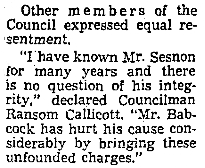 This prompted some strong words on the Chamber floor, where the next day Sesnon himself stood and said in part: “I regret the necessity of speaking but the action filed yesterday makes it unavoidable. These charges are irresponsible, malicious, vindictive and utterly false. No member of the Council ever entered into such a deal. It is an outrage that we have to face such publicity and I completely resent such statements.”
This prompted some strong words on the Chamber floor, where the next day Sesnon himself stood and said in part: “I regret the necessity of speaking but the action filed yesterday makes it unavoidable. These charges are irresponsible, malicious, vindictive and utterly false. No member of the Council ever entered into such a deal. It is an outrage that we have to face such publicity and I completely resent such statements.”
Alas, that‘s the last we hear of Frank Babcock. Henry Babcock is mentioned one more time, in August of 1958, testifying before the City Council about the estimated value of a regraded Hill.
The Babcocks go on to watch as the CRA, bit by bit, commandeers umpteen millions from City coffers, displaces 9,000 people, and eventually gobbles up 136 acres. In the Autumn of 1961 the first CRA-demo‘d building goes down–the Hillcrest. Frank Babcock‘s Dome stands proud until she burns in the Summer of ‘64.
Henry Babcock‘s city of apartment buildings on the Hill never quite materializes the way he planned it.

